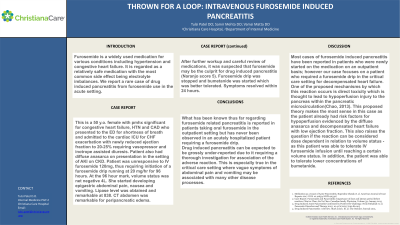Tuesday Poster Session
Category: Biliary/Pancreas
P3498 - Thrown for a Loop: Intravenous Furosemide-Induced Pancreatitis
Tuesday, October 29, 2024
10:30 AM - 4:00 PM ET
Location: Exhibit Hall E

.jpg)
Tulsi Patel, DO
Christiana Care Health System
Elk Grove Village, IL
Presenting Author(s)
Tulsi Patel, DO1, Samir Mehta, DO2, Vamsi Matta, DO2
1Christiana Care Health System, Elk Grove Village, IL; 2Christiana Care Health System, Newark, DE
Introduction: Furosemide is a widely used medication for various conditions including hypertension and congestive heart failure. It is regarded as a relatively safe medication with the most common side effect being electrolyte imbalances. We report a rare case of drug induced pancreatitis from furosemide use in the acute setting.
Case Description/Methods: This 50 yo female with pmhx of ischemic cardiomyopathy who presented for dyspnea and admitted to the cardiac ICU for CHF exacerbation with newly reduced ejection fraction to 20-25% requiring vasopressor and inotrope assisted diuresis. Patient also had diffuse anasarca on presentation in the setting of AKI on CKD. Patient was unresponsive to IV furosemide 120mg, thus required initiation of a furosemide drip running at 20 mg/hr for 96 hours. Following 96 hours on the furosemide drip, volume status was net negative 4L. She started developing epigastric abdominal pain, nausea and vomiting. Lipase level was obtained and remarkable at 838. CT abdomen was remarkable for peripancreatic edema. In the absence of other etiologies and review of medications, it was suspected that furosemide may be the culprit for drug induced pancreatitis (Naranjo score 5). Furosemide drip was discontinued and transitioned to bumetanide, which resulted in resolution of symptoms within 24 hours.
Discussion: Drug induced pancreatitis is grossly under-reported due to it requiring a thorough investigation for association of the adverse reaction. Most cases of furosemide-induced pancreatitis have been reported in patients who were newly started on the medication on an outpatient basis; however our case focuses on a patient who required a furosemide drip in the critical care setting for decompensated heart failure. One of the proposed mechanisms by which this reaction occurs is direct toxicity which is thought to lead to hypoperfusion injury to the pancreas within the pancreatic microcirculation. In the case of our patient, compromised perfusion as well as direct toxicity related to the initiation of the loop diuretic is the most likely etiology. This also raises the question if the reaction can be considered dose dependent in relation to volume status - as this patient was able to tolerate IV furosemide infusion until reaching a certain volume status. In addition, the patient was able to tolerate lower concentrations of bumetanide.
Disclosures:
Tulsi Patel, DO1, Samir Mehta, DO2, Vamsi Matta, DO2. P3498 - Thrown for a Loop: Intravenous Furosemide-Induced Pancreatitis, ACG 2024 Annual Scientific Meeting Abstracts. Philadelphia, PA: American College of Gastroenterology.
1Christiana Care Health System, Elk Grove Village, IL; 2Christiana Care Health System, Newark, DE
Introduction: Furosemide is a widely used medication for various conditions including hypertension and congestive heart failure. It is regarded as a relatively safe medication with the most common side effect being electrolyte imbalances. We report a rare case of drug induced pancreatitis from furosemide use in the acute setting.
Case Description/Methods: This 50 yo female with pmhx of ischemic cardiomyopathy who presented for dyspnea and admitted to the cardiac ICU for CHF exacerbation with newly reduced ejection fraction to 20-25% requiring vasopressor and inotrope assisted diuresis. Patient also had diffuse anasarca on presentation in the setting of AKI on CKD. Patient was unresponsive to IV furosemide 120mg, thus required initiation of a furosemide drip running at 20 mg/hr for 96 hours. Following 96 hours on the furosemide drip, volume status was net negative 4L. She started developing epigastric abdominal pain, nausea and vomiting. Lipase level was obtained and remarkable at 838. CT abdomen was remarkable for peripancreatic edema. In the absence of other etiologies and review of medications, it was suspected that furosemide may be the culprit for drug induced pancreatitis (Naranjo score 5). Furosemide drip was discontinued and transitioned to bumetanide, which resulted in resolution of symptoms within 24 hours.
Discussion: Drug induced pancreatitis is grossly under-reported due to it requiring a thorough investigation for association of the adverse reaction. Most cases of furosemide-induced pancreatitis have been reported in patients who were newly started on the medication on an outpatient basis; however our case focuses on a patient who required a furosemide drip in the critical care setting for decompensated heart failure. One of the proposed mechanisms by which this reaction occurs is direct toxicity which is thought to lead to hypoperfusion injury to the pancreas within the pancreatic microcirculation. In the case of our patient, compromised perfusion as well as direct toxicity related to the initiation of the loop diuretic is the most likely etiology. This also raises the question if the reaction can be considered dose dependent in relation to volume status - as this patient was able to tolerate IV furosemide infusion until reaching a certain volume status. In addition, the patient was able to tolerate lower concentrations of bumetanide.
Disclosures:
Tulsi Patel indicated no relevant financial relationships.
Samir Mehta indicated no relevant financial relationships.
Vamsi Matta indicated no relevant financial relationships.
Tulsi Patel, DO1, Samir Mehta, DO2, Vamsi Matta, DO2. P3498 - Thrown for a Loop: Intravenous Furosemide-Induced Pancreatitis, ACG 2024 Annual Scientific Meeting Abstracts. Philadelphia, PA: American College of Gastroenterology.
